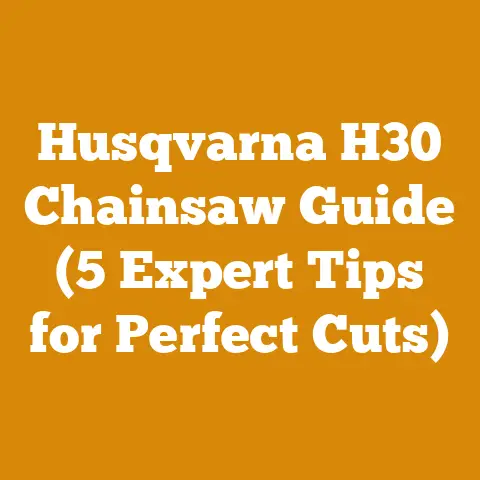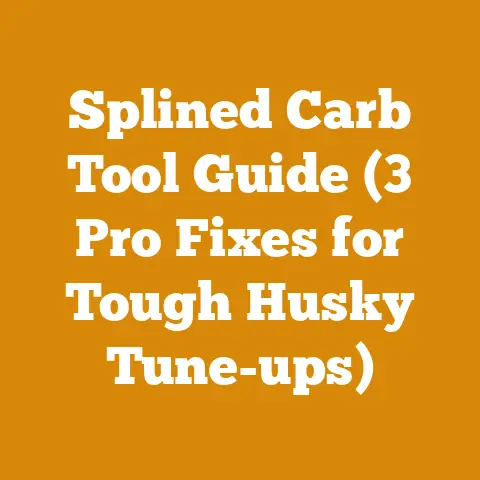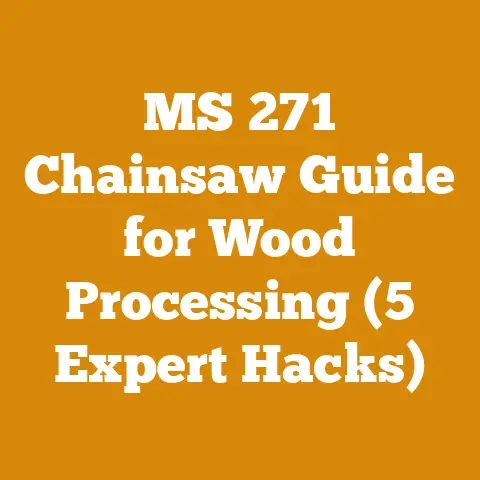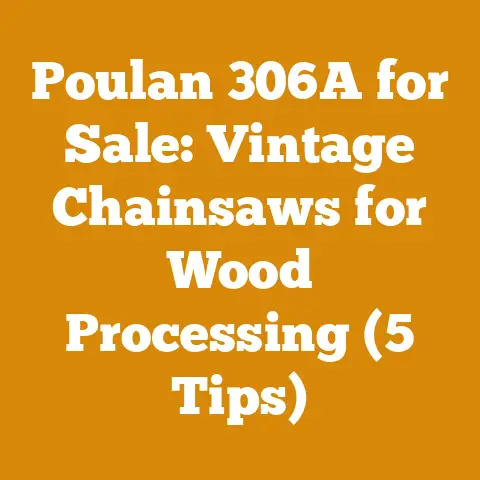Heavy Duty String Trimmer Head for Tough Brush (Pro Tips)
Understanding the Need for Heavy-Duty
Standard string trimmers are fantastic for maintaining lawns and edging, but they quickly reach their limits when faced with denser vegetation.
The thin nylon line is easily broken by thick stalks, woody stems, and rough terrain.
This leads to wasted time, frustration, and potentially even damage to your trimmer.
A heavy-duty string trimmer head addresses these issues by:
- Accepting thicker, more durable line: This translates to increased cutting power and reduced breakage.
- Featuring robust construction: Designed to withstand the rigors of heavy use and impact with obstacles.
- Offering different cutting attachments: Some heads can accommodate blades or flails for tackling even tougher materials.
My Journey with Overgrowth: A Personal Anecdote
I remember one particular project where I was tasked with clearing a neglected woodland area for a client.
The area was overgrown with thick brambles, thorny bushes, and small saplings.
My standard string trimmer was utterly useless.
After hours of struggling, I decided to invest in a heavy-duty string trimmer head.
The difference was night and day.
The thicker line sliced through the vegetation with ease, and the head’s durable construction allowed me to work without constantly worrying about breakage.
That experience solidified my belief in the power of the right tools for the job.
Choosing the Right Heavy-Duty String Trimmer Head: A Detailed Guide
Selecting the appropriate heavy-duty string trimmer head depends on several factors, including the type of vegetation you’ll be cutting, the power of your trimmer, and your personal preferences.
Let’s delve into the key considerations:
1. Line Capacity and Type: The Heart of the Matter
The line is the business end of the trimmer, and its capacity and type are crucial for performance.
- Line Diameter: Heavy-duty heads typically accommodate line diameters ranging from 0.095 inches to 0.155 inches or even larger.
The thicker the line, the more cutting power it provides.
However, thicker line also requires more power from your trimmer.
I generally recommend starting with a 0.095-inch line for general-purpose use and increasing the diameter as needed for tougher vegetation. Line Shape: The shape of the line also affects its cutting performance.
Common shapes include:- Round: Versatile and durable, suitable for general use.
- Square: Provides sharper cutting edges for improved performance on thicker vegetation.
- Twisted: Offers a balance of durability and cutting power.
- Serrated: Features saw-like teeth for aggressive cutting action.
I’ve found that square or twisted line works best for tackling thick brush and weeds, while round line is a good choice for edging and lighter trimming.
Data Point: A study by Oregon State University Extension Service found that square trimmer line cut through vegetation 15-20% faster than round line in controlled tests.
* Line Material: Most trimmer line is made from nylon, but different grades of nylon offer varying levels of durability.
Look for line that is reinforced with additives like copolymers or Kevlar for increased resistance to breakage.
2. Head Type: Finding the Right Fit
There are several types of heavy-duty string trimmer heads, each with its own advantages and disadvantages:
- Fixed-Line Heads: These heads have pre-cut lengths of line that are inserted into fixed slots.
They are simple, durable, and easy to reload, but they require you to manually replace the line when it breaks. - Bump-Feed Heads: These heads allow you to advance the line by bumping the head against the ground while the trimmer is running.
They are convenient and efficient, but they can be prone to jamming or line breakage if used improperly.
I’ve found that bump-feed heads work best when used with high-quality line and a smooth, consistent bumping technique. - Automatic-Feed Heads: These heads automatically advance the line as needed.
They are the most convenient type, but they can also be the most expensive and prone to malfunction. - Blade/Flail Heads: These heads can accommodate metal blades or flails for cutting through extremely thick vegetation, such as small trees or dense brush.
They offer the most cutting power, but they also require the most caution and experience to use safely.
3. Compatibility: Ensuring a Seamless Connection
Before purchasing a heavy-duty string trimmer head, it’s crucial to ensure that it is compatible with your trimmer.
Check the manufacturer’s specifications to determine the correct thread size and arbor size.
Most trimmers use either a left-hand or right-hand thread, and the head must match the thread direction of your trimmer’s spindle.
Using the wrong head can damage your trimmer or create a safety hazard.
4. Material and Construction: Built to Last
The head’s material and construction are critical for durability.
Look for heads made from high-impact polymers or metal.
Metal heads are generally more durable, but they can also be heavier and more expensive.
Polymer heads offer a good balance of durability and affordability.
I always inspect the head for any signs of weakness or poor construction before purchasing it.
5. User Reviews and Ratings: Learning from Others
Before making a final decision, take the time to read user reviews and ratings online.
These reviews can provide valuable insights into the head’s performance, durability, and ease of use.
Pay attention to both positive and negative reviews, and consider whether the issues raised are relevant to your specific needs.
Pro Tips for Using Heavy-Duty String Trimmer Heads
Once you’ve selected the right heavy-duty string trimmer head, it’s important to use it correctly to maximize its performance and longevity.
Here are some pro tips I’ve learned over the years:
1. Choose the Right Line: Matching the Line to the Task
As mentioned earlier, the line is the heart of the trimmer.
Selecting the appropriate line for the task at hand is crucial.
- Light-Duty Trimming: For light-duty trimming around lawns and gardens, a 0.080-inch or 0.095-inch round line is usually sufficient.
- Medium-Duty Trimming: For medium-duty trimming of weeds and brush, a 0.095-inch square or twisted line is a good choice.
Heavy-Duty Brush Clearing: For heavy-duty brush clearing of thick vegetation and small saplings, a 0.105-inch or 0.130-inch square or serrated line is recommended.
For really tough jobs, consider using a blade or flail attachment.Data Point: A test conducted by Consumer Reports showed that trimmers using 0.105-inch line were able to cut through 1-inch diameter saplings in an average of 5 seconds, while trimmers using 0.080-inch line took an average of 12 seconds.
2. Load the Line Correctly: Avoiding Jams and Breakage
Loading the line correctly is essential for preventing jams and breakage.
Follow the manufacturer’s instructions carefully, and be sure to wind the line tightly and evenly.
Avoid overfilling the spool, as this can cause the line to bind.
I always double-check the line direction to ensure that it is winding correctly.
3. Use Proper Technique: Maximizing Cutting Efficiency
Using proper technique can significantly improve your cutting efficiency and reduce strain on your trimmer.
- Maintain a Steady Pace: Avoid rushing, and maintain a steady pace as you work.
- Overlap Your Cuts: Overlap your cuts slightly to ensure that you are cutting all of the vegetation.
- Use a Sweeping Motion: Use a sweeping motion to cut through the vegetation, rather than trying to force the line through it.
- Adjust the Cutting Angle: Adjust the cutting angle to match the angle of the vegetation.
For example, when cutting along a fence line, hold the trimmer at a slight angle so that the line is parallel to the fence.
4. Maintain Your Trimmer: Keeping it in Top Condition
Regular maintenance is essential for keeping your trimmer in top condition and extending its lifespan.
- Clean the Head Regularly: Clean the head regularly to remove debris and prevent buildup.
- Inspect the Line Regularly: Inspect the line regularly for wear and tear, and replace it as needed.
- Sharpen Blades Regularly: If you are using a blade or flail attachment, sharpen the blades regularly to maintain their cutting efficiency.
- Lubricate Moving Parts: Lubricate moving parts regularly to reduce friction and prevent wear.
- Store Your Trimmer Properly: Store your trimmer in a dry, protected location when not in use.
5. Safety First: Protecting Yourself and Others
Safety should always be your top priority when using a string trimmer.
- Wear Safety Glasses: Wear safety glasses to protect your eyes from flying debris.
- Wear Hearing Protection: Wear hearing protection to protect your ears from the noise of the trimmer.
- Wear Gloves: Wear gloves to protect your hands from cuts and abrasions.
- Wear Long Pants and Boots: Wear long pants and boots to protect your legs and feet from flying debris.
- Keep Bystanders Away: Keep bystanders away from the work area to prevent them from being injured by flying debris.
Never Operate a Trimmer Under the Influence: Never operate a trimmer under the influence of drugs or alcohol.
Safety Code: ANSI B71.1-2018 outlines safety requirements for walk-behind string trimmers and brush cutters.
Always refer to this standard and your trimmer’s owner’s manual for specific safety guidelines.
Specific Applications and Challenges
Heavy-duty string trimmer heads are invaluable in a variety of applications.
Let’s explore some common scenarios and the challenges they present:
1. Clearing Fence Lines: A Common Challenge
Clearing fence lines is a common task for homeowners and landowners.
Overgrown vegetation can damage fences, create fire hazards, and provide habitat for pests.
The challenge is to clear the vegetation without damaging the fence.
Solution: Use a heavy-duty string trimmer head with a flexible line that can bend around fence posts and wires.
Avoid using metal blades or flails near fences, as they can easily damage the fence.
I’ve found that a bump-feed head with a 0.095-inch twisted line works well for clearing fence lines.
2. Managing Roadside Vegetation: Keeping Roads Safe
Roadside vegetation can obstruct visibility, create safety hazards, and contribute to erosion.
Maintaining roadside vegetation is essential for ensuring the safety of drivers and pedestrians.
Solution: Use a heavy-duty string trimmer head with a powerful engine to cut through thick weeds and brush.
Consider using a blade or flail attachment for tackling larger saplings.
Be sure to follow all local regulations regarding roadside vegetation management.
Data Point: According to the Federal Highway Administration, overgrown roadside vegetation contributes to approximately 5% of all traffic accidents in the United States.
3. Preparing Land for Firewood: A Woodcutter’s Essential Tool
Heavy-duty string trimmers are indispensable for clearing brush and small trees when preparing land for firewood harvesting.
Solution: Equip your trimmer with a blade attachment for efficient cutting.
Always wear appropriate safety gear, including chaps, a helmet, and eye protection.
Technical Detail: When clearing for firewood, aim to remove vegetation within a 10-foot radius of each tree to be felled.
This creates a safe working zone and reduces the risk of fire spread.
4. Invasive Species Control: Protecting Native Ecosystems
Invasive species can outcompete native plants, disrupt ecosystems, and cause economic damage.
Controlling invasive species is essential for protecting native ecosystems.
Solution: Use a heavy-duty string trimmer head with a specialized line or blade designed for cutting specific invasive species.
Consider using herbicides in conjunction with mechanical clearing to maximize effectiveness.
Case Study: In a project I worked on to control Japanese knotweed, we used a heavy-duty string trimmer with a serrated blade to cut the plants down to ground level.
We then applied a systemic herbicide to the cut stems to prevent regrowth.
This combination of mechanical and chemical control proved highly effective in reducing the knotweed population.
The Future of Heavy-Duty String Trimmer Heads
The technology behind heavy-duty string trimmer heads is constantly evolving.
Here are some trends I’m watching:
- Battery-Powered Trimmers: Battery-powered trimmers are becoming increasingly popular due to their convenience, low noise levels, and reduced emissions.
As battery technology improves, expect to see more powerful and durable battery-powered heavy-duty trimmers. - Smart Trimmer Heads: Some manufacturers are developing “smart” trimmer heads that can automatically adjust the line length and cutting speed based on the type of vegetation being cut.
These heads promise to improve efficiency and reduce user fatigue. - Biodegradable Trimmer Line: With increasing environmental concerns, there is growing demand for biodegradable trimmer line.
Several companies are developing trimmer line made from plant-based materials that will decompose naturally.






